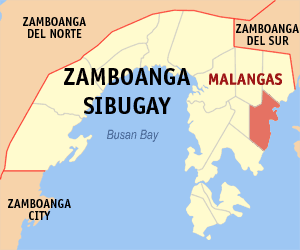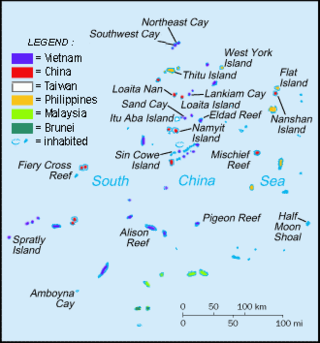
Zamboanga was a province of the Philippines located in the western region of the southern island of Mindanao, Philippines.

Bataan, officially the Province of Bataan, is a province in the Central Luzon region of the Philippines. Its capital is the city of Balanga while Mariveles is the largest town in the province. Occupying the entire Bataan Peninsula on Luzon, Bataan is bordered by the provinces of Zambales and Pampanga to the north. The peninsula faces the South China Sea to the west and Subic Bay to the north-west, and encloses Manila Bay to the east.

Zamboanga Peninsula is an administrative region in the Philippines, designated as Region IX. It consists of three provinces including four cities and the highly urbanized Zamboanga City. The region was previously known as Western Mindanao before the signing of Executive Order No. 36 of 2001. The city of Zamboanga was designated as the regional center until Pagadian was designated as its new regional center, although Zamboanga City remains the region's cultural, economic, and educational center.

Ipil, officially the Municipality of Ipil, is a 1st class municipality and capital of the province of Zamboanga Sibugay, Philippines. According to the 2020 census, it has a population of 89,401 people. Ipil is the most populous municipality of Zamboanga Sibugay, and the second most populous in Region IX after Sindangan.

Malangas, officially the Municipality of Malangas, is a 3rd class municipality in the province of Zamboanga Sibugay, Philippines. According to the 2020 census, it has a population of 32,022 people.

Lopez Holdings Corporation is a Filipino conglomerate founded by the brothers Eugenio Lopez, Sr. and Fernando Lopez, Sr. It has substantial holdings in the public service and utilities sector in the Philippines and serves as the Lopez family's publicly listed holding company for investments in major development sectors such as broadcasting and cable; telecommunications; power generation and distribution; manufacturing; and property development. It added to its portfolio investments in other basic service sectors but has also since sold its interest in banking, toll roads, information technology, and health care delivery.

Petron Corporation is the largest oil refining and marketing company in the Philippines, supplying more than a third of the country's oil requirements. It operates a refinery in Limay, Bataan with a rated capacity of 180,000 barrels per day (29,000 m3/d). From the refinery, Petron moves its products mainly by sea to 32 depots and terminals throughout the country.

The Ministry of Petroleum and Natural Gas (MOP&NG) is a ministry of the government of India responsible for the exploration, production, refining, distribution, marketing, import, export, and conservation of petroleum, natural gas, petroleum products, and liquefied natural gas in the country. The ministry is headed by the Cabinet Minister Hardeep Singh Puri. M. M. Kutty is the Secretary of the Ministry. Dharmedndra Pradhan serving as the minister from 26 May 2014 to 7 July 2021 is the longest serving minister till date.

Philippines and the Spratly Islands – this article discusses the policies, activities and history of the Republic of the Philippines in the Spratly Islands from the Philippine perspective. Non-Philippine viewpoints regarding Philippine occupation of several islands are currently not included in this article.
Ipil Airport is an airport serving the general area of Ipil, the capital of the province of Zamboanga Sibugay in the Philippines. It is the one of the 2 airport in the province other than Malangas Airfield. The airport is classified as a community airport by the Civil Aviation Authority of the Philippines, a body of the Department of Transportation that is responsible for the operations of not only this airport but also of all other airports in the Philippines except the major international airports.

First Philippine Holdings Corporation (FPH) is a management and investment company whose major business is power generation and distribution, with strategic initiatives in manufacturing and property development. FPH is a member of the Lopez Group of Companies.
COC No. 41 - Malangas or the Malangas Coal Reservation is a Coal Reservation in Zamboanga Sibugay, Philippines exploited by the Philippine National Oil Company - Exploration Corporation (PNOC-EC).

Energy in Greece is dominated by fossil gas and oil. Electricity generation is dominated by the one third state owned Public Power Corporation. In 2009 DEI supplied for 85.6% of all electric energy demand in Greece, while the number fell to 77.3% in 2010. Almost half (48%) of DEI's power output in 2010 was generated using lignite. 12% of Greece's electricity comes from hydroelectric power plants and another 20% from natural gas. Between 2009 and 2010, independent companies' energy production increased by 56%, from 2,709 Gigawatt hour in 2009 to 4,232 GWh in 2010.
Energy Development Corporation is the largest producer of geothermal energy in the Philippines and the second largest in the world. It is involved in alternative energy projects, including geothermal, hydroelectric and wind energy projects. The company was formerly owned by the Philippine National Oil Company, a state corporation owned by the Republic of the Philippines engaged in the exploration of resources, production of energy and distribution of power supply to smaller electricity distributor. EDC was privatized and acquired by the Lopez Group as part of its energy and power supply utility business units.
In the Philippines, a government-owned and controlled corporation (GOCC), sometimes with an "and/or", is a state-owned enterprise that conducts both commercial and non-commercial activity. Examples of the latter would be the Government Service Insurance System (GSIS), a social security system for government employees. There are 219 GOCCs as of 2022. GOCCs both receive subsidies and pay dividends to the national government.
The Malampaya gas field or the Malampaya-Camago field is a deepwater gas-condensate reservoir, located in the Service Contract 38 license area, located offshore, 65 kilometres (40 mi) northwest of the island of Palawan, Philippines.

The electricity sector in the Philippines provides electricity through power generation, transmission, and distribution to many parts of the country. The Philippines is divided into three electrical grids, one each for Luzon, the Visayas and Mindanao. As of June 2016, the total installed capacity in the Philippines was 20,055 megawatts (MW), of which 14,348 MW was on the Luzon grid. As of June, 2016, the all-time peak demand on Luzon was 9,726 MW at 2:00 P.M. on May 2, 2016; on Visayas was 1,878 MW at 2:00 P.M. on May 11, 2016; and on Mindanao was 1,593 MW at 1:35 P.M. on June 8, 2016. However, about 12% of Filipinos have no access to electricity. The Philippines is also one of the countries in the world that has a fully functioning electricity market since 2006 called the Philippine Wholesale Electricity Spot Market(WESM) and is operated by an independent market operator.
Udenna Corporation is a holdings company made by the Udenna Group of Companies which is based in Davao City, Philippines, and founded by businessman Dennis Uy. Primarily involved in the petroleum and shipping industry in its initial years, the company later diversified and became involved in other sectors such as real estate and telecommunications.
LCS Group of Companies, also known as LCS Holdings Inc., is a Philippine conglomerate. The LCS Group is founded by Filipino politician Luis Crisologo Singson who serves as its chairman.












